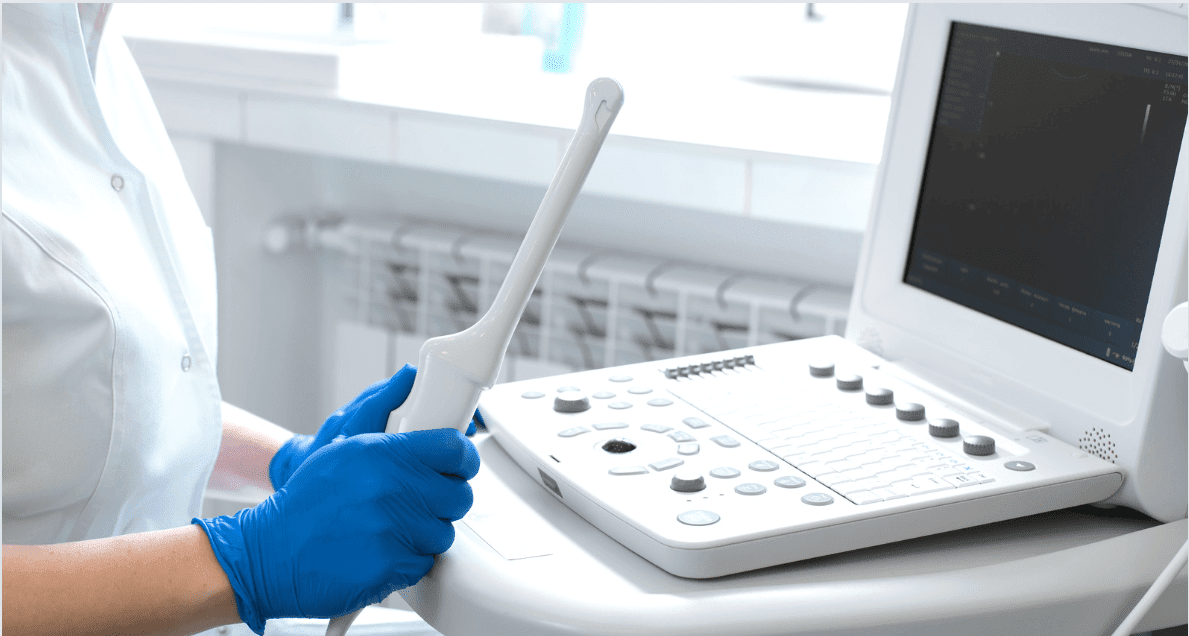If you have endometriosis and/or you are looking for an endometriosis diagnosis, it is imperative to get the correct kind of endometriosis ultrasound so you can go on to have effective management and treatment.
In Australia, a good quality endometriosis ultrasound is now considered diagnostically sufficient to diagnose endometriosis. This blog post will explain the different types of ultrasounds used for endometriosis, what they can detect, their proper preparation, and details you need to be aware of to ensure your doctor has ordered the correct kind of ultrasound for you.
Deep Infiltrating Endometriosis (D.I.E.) Ultrasounds
This type of ultrasound is often referred to as a “deep endometrial ultrasound”, a “deep endometrial scan”, or simply an “endometriosis ultrasound”.
As it sounds, it is specifically designed to scan for deep infiltrating endometriosis (D.I.E.). D.I.E. refers to endometriosis that penetrates deeply into pelvic tissues and organs. This specialised ultrasound can detect:
- Endometriosis nodules on the bowel, bladder, and other pelvic organs
- Adhesions (scar tissue caused by endometriosis)
- Detailed involvement of pelvic structures
Transvaginal Ultrasounds
A transvaginal ultrasound is a common imaging technique used to generally examine the reproductive organs. This type of ultrasound provides detailed images of the uterus, ovaries, and surrounding structures. This type of endometriosis ultrasound is excellent for identifying:
- Endometriomas (ovarian cysts caused by endometriosis)
- Superficial endometriosis (involves endometrial-like tissue growing on the surface of pelvic organs and the peritoneum)
- Adenomyosis (endometriosis within the muscular wall of the uterus)
- General pelvic anatomy and abnormalities.
Both of these ultrasounds are often conducted at the same time to provide a comprehensive view of the pelvic region so an endometriosis diagnosis can be made.
What Happens at an Endometriosis Ultrasound Examination?
During the endometriosis ultrasound examinations, the following assessments are typically performed:
- Uterus and Ovaries: Evaluation for the presence and size of endometriosis deposits.
- Kidneys: Assessment to exclude hydronephrosis, which may indicate ureteric obstruction due to D.I.E.
- Bladder and Distal Ureters: Examination for endometriosis involvement.
- Bowel: Evaluation of the caecum, rectum, and sigmoid for endometriosis nodules.
- Vaginal Wall and Pouch of Douglas: Examination for free fluid, adhesions, and nodules.
- Adenomyosis: Check for associated adenomyosis within the uterus.
- Uterine and Ovarian Mobility: Assessment of tenderness and mobility to indicate the extent of adhesions and endometriosis.
When is the Best Time in the Menstrual Cycle for an Endometriosis Ultrasound?
The timing of an endometriosis ultrasound can greatly impact the visibility of endometriosis. Thus it’s best to schedule the ultrasound during the early follicular phase of your menstrual cycle (days 5-10 – with day 1 being the first day of bright red flow of your period). During this time, the endometrial lining is thinner, making ovarian endometriomas and other lesions more easily visualised.
Bowel Prep Enhances Visualisation on an Endometriosis Ultrasound
To achieve optimal visualisation of the pelvic organs and endometriosis lesions, it is crucial for the rectum and sigmoid colon to be free of faeces and gas. This is why expert women’s health sonography clinics will always recommend using some sort of bowel prep a few hours before the scan. Good examples of bowel prep are pharmacy enemas (like Microlax), or even doing your own water or coffee enema at home before. This preparation helps ensure clear and unobstructed images.
It’s also worth noting that most GPs and mainstream sonography centres understand the benefits of using bowel prep before an endometriosis ultrasound. Therefore, ask your doctor to specify “Deep endometriosis ultrasound + transvaginal with bowel prep” on your referral to ensure thorough examination of all necessary areas.
How Effective are Endometriosis ultrasounds?
Whilst endometriosis ultrasounds are highly effective, accuracy rates can vary. For example, transvaginal ultrasounds are very effective at identifying ovarian endometriomas, with accuracy rates often exceeding 90%, where the same ultrasound is less effective at seeing superficial endometriosis (which accounts for 70% of all cases).
Deep endometriosis ultrasounds are more effective at detecting lesions and adhesions in deeper tissues, such as the bladder, bowel, and other pelvic organs. But ultimately it comes down to the skill of the technician, the interpretation of the scan by the specialist radiologist, the timing and bowel preparation.
Special Consideration for Young Patients
Endometriosis ultrasounds are not suitable for young teenage girls or for those who have not yet been sexually active. In these cases, a standard pelvic ultrasound combined with a day 21 CA-125 blood test and symptom analysis is the best way to assess for possible endometriosis. This approach is less invasive and more appropriate for younger patients while still providing valuable diagnostic information.
Where is the Best Place to Go for an Endometriosis Ultrasound?
It is best for women to seek out an ultrasound (sonography) clinic that specialises in women’s reproductive health.
In Australia, you can easily access these clinics in every major city. However, they are much harder to find in Europe, and anywhere between the east and west coasts of the USA.
If your family doctor is unable to recommend a specialised women’s ultrasound clinic, here’s what you can do:
- Contact Local Sonography Clinics: Call your local sonography clinic (sometimes these are in hospitals) to ask if they can conduct endometriosis ultrasounds or to ask if they can provide you with a referral.
- Check for Expertise: Ask if they have experience with endometriosis ultrasounds. Some standard centres might be able to conduct an endometriosis ultrasound, but might lack the necessary expertise to advise you in the preparation techniques. If this is your only option you can book the appointment between days 5-10 of your cycle and perform the bowel prep at home yourself before the appointment.
- Speak to other professionals: Research local professionals who also assist women with reproductive diseases like endometriosis. This may include nutritionists, naturopaths, acupuncturists, pelvic floor physiotherapists, IVF clinics, fertility doctors, gynaecologists and/or excision surgeons. These specialists often know the best places to go for endometriosis care in your area.
This approach will help you get the most accurate and comprehensive endometriosis ultrasound.
Conclusion
An endometriosis ultrasound is a vital tool in the diagnosis and management of endometriosis. Understanding the different types of ultrasounds, the best timing for the procedure, and the importance of bowel prep can significantly enhance the effectiveness of the examination.
If you are looking for more guidance about how to get diagnosed with endometriosis, please book a consultation with me or download my free guide here










